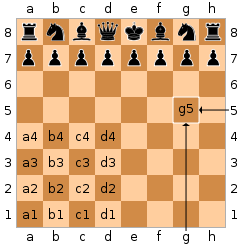
Back تدوين جبري (شطرنج) Arabic Cəbri notasiya (şahmat) Azerbaijani Notació algebraica Catalan Algebraický zápis (šachy) Czech Nodiant algebraidd (gwyddbwyll) Welsh Algebraisk notation (skak) Danish Αλγεβρική σκακιστική γραφή Greek Algebra notado (Ŝako) Esperanto Notación algebraica Spanish Notazio aljebraiko Basque

Algebraic notation is the standard method of chess notation, used for recording and describing moves. It is based on a system of coordinates to identify each square on the board uniquely.[1] It is now almost universally used by books, magazines, newspapers and software, and is the only form of notation recognized by FIDE,[2] the international chess governing body.
An early form of algebraic notation was invented by the Syrian player Philip Stamma in the 18th century. In the 19th century, it came into general use in German chess literature and was subsequently adopted in Russian chess literature. Descriptive notation, based on abbreviated natural language, was generally used in English language chess publications until the 1980s. Similar descriptive systems were in use in Spain and France. A few players still use descriptive notation, but it is no longer recognized by FIDE, and may not be used as evidence in the event of a dispute.
The term "algebraic notation" may be considered a misnomer, as the system is unrelated to algebra.[1]
- ^ a b Hooper, David; Whyld, Kenneth (1996) [First pub. 1992]. "standard notation". The Oxford Companion to Chess (2nd ed.). Oxford University Press. p. 389. ISBN 0-19-280049-3.
- ^ "E. Miscellaneous / 01. Laws of Chess / FIDE Laws of Chess taking effect from 1 January 2023 / FIDE Handbook". International Chess Federation (FIDE). Retrieved 2024-11-30.
© MMXXIII Rich X Search. We shall prevail. All rights reserved. Rich X Search